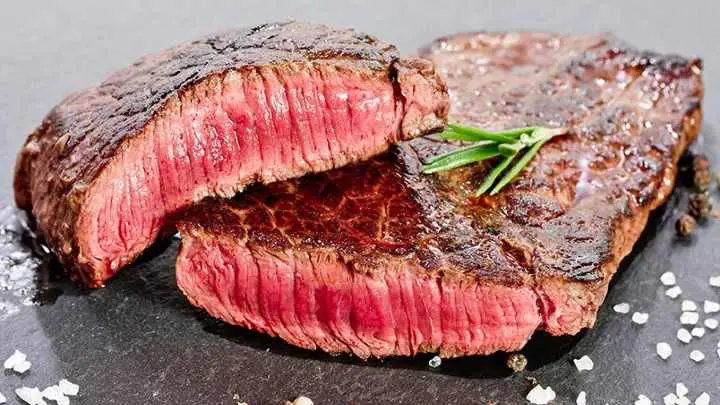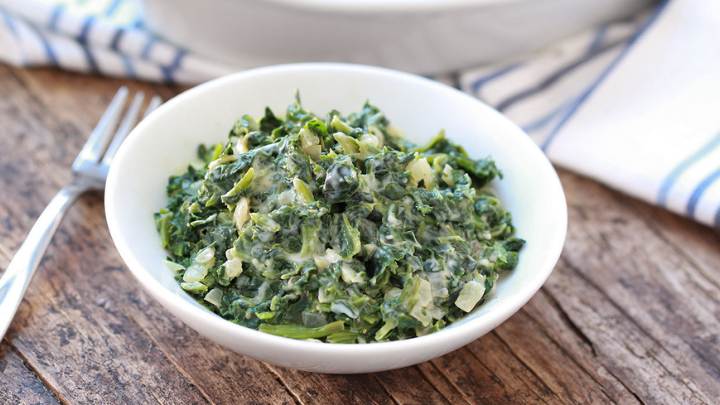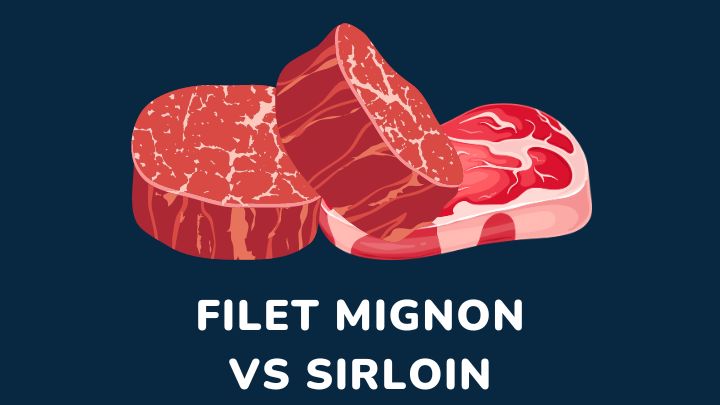When craving a delicious, juicy but lean steak, what’s your preferred option between filet mignon vs sirloin?
Steak lovers find it fun to try out different varieties of steak and figure out which is the best. However, when it comes to pleasing your taste buds, it’s all about what you prefer.
Among the array of options, filet mignon and sirloin are popular steaks in the market, and they share quite some features in common.
In this article, you will learn what makes these two beloved cuts of beef stand out, the best cooking techniques for each, and how you can pair them to create delicious healthy meals.
What is filet mignon?

Filet mignon is a special cut of beef loved by many for its tenderness and delicious flavor.
It comes from the tenderloin area of the cow, which is the most tender part of the animal because it doesn’t do much work. This cut is prized for its melt-in-your-mouth texture and mild, buttery flavor.
Filet mignon is usually cut into thick, round pieces, and it’s often served as a steak. Its origins trace back to France, where it was first enjoyed by royalty.
Today, filet mignon is a favorite choice for fancy dinners and special occasions due to its luxurious taste and texture. Whether grilled, pan-seared, or roasted, filet mignon always promises a delightful dining experience.
What is sirloin?

Sirloin, a beloved cut of beef, originates from the back area of the cow, close to the loin. Unlike the tenderloin, the sirloin area does more work, resulting in a meatier texture and stronger beef flavor.
Its versatility shines through various cuts, including steaks, roasts, and ground beef. Sirloin steaks boast ample size and thickness, making them ideal for grilling or roasting to perfection.
With roots tracing back to England, sirloin has been a cherished choice for meat enthusiasts for generations.
Its robust flavor and succulent texture make it a staple for gatherings and family meals alike. Whether served as a sizzling steak or incorporated into savory stews, sirloin promises a satisfying beef experience that delights the palate with every bite.
Filet mignon vs sirloin – Nutritional profile
Filet mignon
According to the USDA, 3-ounce of filet mignon contains:
- Calories: 227
- Total Fat: 15 g
- Saturated Fat: 6 g
- Cholesterol: 82 mg
- Sodium: 46 mg
- Potassium: 280 mg
- Carbohydrates: 0 g
- Protein: 22 g
- It also contains iron, zinc, vitamin B6, and B12 as well as a low amount of sodium (less than 50mg)
Sirloin
According to the USDA, 100 grams of sirloin contains:
- Calories: 244
- Total Fat: 14 g
- Saturated fat: 6 g
- Cholesterol: 92 mg
- Sodium: 56 mg
- Potassium 336 mg
- Total Carbohydrate: 0 g
- Dietary fiber: 0 g
- Granulated Sugar: 0 g
- Protein: 27 g
- It also contains magnesium, iron, Vitamin D, and Vitamin B6
Filet mignon vs sirloin – Flavor and texture
Filet mignon and sirloin offer distinct flavor profiles and textures that cater to different preferences.
While filet mignon boasts a mild, buttery flavor and a tender texture, sirloin presents a robust, beefy flavor with a firmer, meatier texture.
Regarding appearance, filet mignon is typically smaller and rounder, while sirloin steaks tend to be larger and thicker. These differences in size and shape can impact cooking times and presentation on the plate.
Several factors influence the taste and mouthfeel of these cuts. The level of marbling, or fat streaks within the meat, contributes to flavor and tenderness.
Additionally, the aging process, cooking method, and seasoning choices play vital roles in enhancing or altering the final taste and texture of the steak.
Filet mignon vs sirloin – Cooking methods
Best cooking techniques for filet mignon
Grilling
- Preheat the grill to high heat
- Season filet mignon with salt, pepper, and desired spices
- Grill over direct heat for 4-6 minutes per side for medium-rare
- Let rest before serving
Pan-searing
- Heat a skillet over medium-high heat.
- Add oil or butter to the skillet.
- Sear filet mignon for 3-4 minutes per side until browned.
- Finish cooking in the oven at 400°F (204°C) for 5-7 minutes for medium-rare
- Rest before slicing
Broiling
- Preheat the broiler on a high setting.
- Season filet mignon with salt, pepper, and herbs.
- Place it on a broiler pan and position it under the broiler.
- Cook for 5-7 minutes per side for medium-rare.
- Rest before serving.
These high-heat methods quickly seal in the juices and create a delicious crust on the outside while preserving the tender texture inside.
Best cooking techniques for sirloin
Grilling
- Preheat grill to medium-high heat
- Season sirloin with salt, pepper, and your favorite spices
- Grill over direct heat for 4-6 minutes per side for medium-rare
- Let rest before slicing.
Roasting
- Preheat oven to 400°F (204°C)
- Season sirloin with salt, pepper, and herbs
- Place on a roasting rack in a roasting pan
- Roast for 15-20 minutes per pound for medium-rare
- Let rest before slicing
Pan-searing
- Heat a skillet over medium-high heat
- Season sirloin with salt and pepper
- Add oil or butter to the skillet
- Sear sirloin for 3-4 minutes per side until browned
- Finish cooking in the oven at 375°F (191°C) for 5-7 minutes for medium-rare
- Rest before serving
These methods allow the meat to develop a rich, caramelized exterior while retaining its juicy interior.
Furthermore, to achieve optimal flavor and tenderness, consider these tips:
Preheat your cooking surface
Whether grilling or pan-searing, make sure your cooking surface is hot before adding the steak. This helps to sear the meat quickly, locking in juices and flavor.
Season generously
Use a mixture of salt, pepper, and your favorite herbs or spices to enhance the natural flavors of the steak.
Let it rest
After cooking, allow the steak to rest for a few minutes before slicing. This allows the juices to be redistributed, ensuring a juicy and tender bite every time.
Use a meat thermometer
For perfect doneness, use a meat thermometer to ensure the steak reaches your desired level of doneness.
For filet mignon, aim for medium-rare to medium, while sirloin can be cooked to medium or medium-well for optimal flavor and tenderness
Filet mignon vs sirloin – Health considerations
When it comes to choosing between filet mignon and sirloin, considering their health benefits and drawbacks is essential for making informed dietary choices.
Filet mignon
Benefits
Filet mignon is a lean cut of beef, making it a good source of protein without excessive saturated fat. It contains essential nutrients like iron and zinc, which are important for overall health and well-being
Drawbacks
Due to its leanness, filet mignon may lack the rich flavor and juiciness of fattier cuts. It tends to be more expensive compared to other cuts of beef, limiting its accessibility for some individuals
Sirloin
Benefits
Sirloin offers a balance of flavor and tenderness, making it a versatile and popular choice for meat lovers. It provides ample protein and essential nutrients, contributing to a balanced diet
Drawbacks
Sirloin can be higher in saturated fat compared to leaner cuts like filet mignon, which may not be ideal for individuals watching their cholesterol levels
Overconsumption of sirloin or other fatty meats may increase the risk of heart disease and other health issues
Impact on cholesterol levels and dietary considerations
Both filet mignon and sirloin can impact cholesterol levels, especially if consumed in large quantities or in combination with high-fat foods.
Individuals with specific health concerns, such as heart disease or diabetes, should moderate their intake of red meat and opt for leaner cuts like filet mignon when possible.
Incorporating a variety of protein sources, including fish, poultry, and plant-based options, can help maintain a balanced and heart-healthy diet.
Moderation and variety are key to enjoying a nutritious and satisfying diet while indulging in delicious steak dinners.
Pairings and side dishes
Pairing the right wine and side dishes with your steak can elevate the dining experience to new heights.
Here are some suggestions to complement filet mignon and sirloin:
Wine pairings for filet mignon
Filet mignon’s delicate flavor and tender texture pair well with lighter red wines.
Consider a Pinot Noir, Merlot, or Cabernet Franc to enhance the subtle nuances of the meat without overpowering it.
The fruity and earthy notes of these wines complement the mild flavor of filet mignon, creating a harmonious balance on the palate.
Wine pairings for sirloin
Sirloin’s robust flavor and meaty texture call for bolder red wines. Opt for a Cabernet Sauvignon, Malbec, or Syrah to match the intensity of the steak.
These full-bodied wines provide a rich and complex flavor profile that stands up to the hearty flavors of sirloin, creating a perfect marriage of taste sensations.
Side dish recommendations
For filet mignon
Roasted vegetables

Enhance the elegance of filet mignon with roasted asparagus, mushrooms, or Brussels sprouts. The earthy flavors and crispy texture of the vegetables contrast beautifully with the tender steak.
Mashed potatoes

Creamy mashed potatoes serve as a comforting and indulgent accompaniment to filet mignon. The creamy texture and buttery flavor of the potatoes provide a luxurious contrast to the lean meat.
Grilled asparagus

The smoky flavor of grilled asparagus complements the delicate taste of filet mignon, while its crunchy texture adds contrast to the tender meat.
Creamy spinach

Indulge in the luxurious combination of creamy spinach and filet mignon. The creamy spinach provides a velvety texture and rich flavor, enhancing the dining experience.
For sirloin
Garlic butter green beans

Add a burst of flavor to your sirloin dinner with garlic butter green beans. The vibrant green color and crisp texture of the beans complement the hearty flavors of the steak.
Loaded baked potatoes

Elevate your sirloin meal with loaded baked potatoes topped with sour cream, cheese, bacon, and chives. The savory and indulgent toppings enhance the richness of the steak, creating a satisfying and memorable dining experience.
Grilled corn on the cob

Enjoy the sweetness and smokiness of grilled corn on the cob with your sirloin. The juicy kernels and charred flavor provide a satisfying contrast to the rich and savory steak.
Crispy onion rings

Add a crunchy and savory element to your sirloin dinner with crispy onion rings. The crispy texture and sweet onion flavor enhance the hearty taste of the steak.
FAQs
Is filet mignon more expensive than sirloin?
Yes, filet mignon is typically more expensive due to its tenderness and limited availability.
Can you substitute filet mignon for sirloin in recipes?
It depends on the recipe. Filet mignon’s tenderness may affect cooking times and results, so consider the dish’s requirements before substituting.
Are there any health benefits to eating steak?
Yes, steak is a good source of protein and essential nutrients like iron and zinc. However, moderation is key to maintaining a balanced diet.
Is filet mignon more tender than sirloin?
Yes, filet mignon is generally more tender than sirloin. This is because filet mignon comes from a less-used muscle area of the cow, resulting in a more tender texture compared to sirloin, which comes from a more active muscle group.
Conclusion
Choosing between filet mignon and sirloin ultimately comes down to personal preference and dietary needs.
Each cut offers its unique combination of flavor, tenderness, and nutritional benefits. Whether you prefer the buttery tenderness of filet mignon or the robust flavor of sirloin, there’s no shortage of delicious ways to enjoy these versatile cuts of beef.
Whichever cut of beef you choose, remember to eat in moderation and create a balanced diet by pairing them with healthy side dishes. This way, you can satisfy both your palate and your health goals.
Do you think beef and steak are the same thing? Learn about their similarities and differences here.
Thanks for reading.
